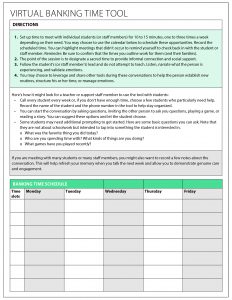TOOLS
Stay connected during crisis
By Katie Brackenridge and Amy Nicholson
Categories: Online learning, Personalization, Social & emotional learningJune 2020
Vol. 41, No. 3
The novel coronavirus is disrupting the way we live, work, and experience school. To halt the spread of infection, to be physically safe, we must distance ourselves from many of the people in our lives. But to be emotionally safe, we need to maintain social connections.
As educators, the most important thing we can do for students during this stressful time is maintain emotional closeness despite physical distance. Similarly, an essential role of education leaders right now is to maintain connection with teachers, support staff, and other colleagues.

The Virtual Banking Time Tool is a strategy modified from a tool for in-person connections to help maintain relationships during school closures. It is based on a similar tool for tracking in-person connections. It was designed for scheduling and tracking check-ins with students, but it can also be used for check-ins with staff.
Why prioritize relationships?
Neuroscience gives us a peek into why relationships are so important, particularly during this stressful time. Learning happens in the limbic system of our brain. It includes the prefrontal cortex (control center), hippocampus (learning and memory), and the amygdala (emotions and reactions). These parts are interconnected and cross-wired, which helps explain why cognitive, social, and emotional development are interdependent.
The limbic system is loaded with receptors for two types of hormones, one responding to stress and one that responds to love and trust. Under stress, high levels of the hormone cortisol flood the limbic system and prevent the three parts from working together. The amygdala — emotional reaction center — is quick to take over, keeping the individual from planning, remembering, regulating, and learning. This reaction is particularly hard for children (and adults) who experience frequent or chronic stress.
Fortunately, the other hormone — oxytocin, which is released when people experience trust, caring, and love — counteracts the effects of cortisol. It allows the limbic system to get rebalanced so that cognitive, social, and emotional functions can be restored. Because caring relationships trigger the release of oxytocin, they are very important for buffering stress, especially now.
Why schedule check-ins?
In the midst of a crisis, we’re all juggling many responsibilities. Despite our best intentions to connect with all of the people we care for, it can be easy to lose track of those we have — and haven’t — talked with and when.
The Virtual Banking Time Tool can help you organize individual, virtual check-ins to ensure consistent and predictable time for personal connections, whether with students or staff.
Some key principles of this tool are:
- The check-ins you schedule should be short but happen on a regular schedule; the key is that they are dependable.
- The check-ins should focus on social support, not instruction or evaluation.
- These connections should be noncontingent; they should not be related to behavior or performance, and not used as rewards or punishments.
- They are intended to be youth-directed (or staff-directed if you are conducting a leader-staff check-in) as much as possible. You may need to do some prompting and offer options to start, but be sure to gradually release control.

Amy Nicholson leads partnerships in the western region of the U.S., building the knowledge and capacity of district and school leaders to support whole-child systems and strategies. Previously, she served as the director of school performance for the UNO Charter School Network in Chicago, as an education pioneer fellow, and as a special projects manager for the Chicago Public Schools. Nicholson began her career as a middle school English Language Arts teacher and a Teach for America corps member.
Categories: Online learning, Personalization, Social & emotional learning
Recent Issues
BUILDING BRIDGES
December 2024
Students benefit when educators bridge the continuum of professional...
CURRICULUM-BASED PROFESSIONAL LEARNING
October 2024
High-quality curriculum requires skilled educators to put it into...
LEARNING TO PIVOT
August 2024
Sometimes new information and situations call for major change. This issue...
GLOBAL PERSPECTIVES
June 2024
What does professional learning look like around the world? This issue...












